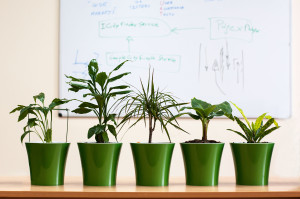 Houseplants are perhaps the most often viewed as decorative elements. Nevertheless, different flowers can be used not only for interior decoration. They can reduce the concentration of contaminants in the room and even such detrimental compounds as, for example, benzene, formaldehyde, toluene and xylene. Plants are also able to reduce the amount of germs in the air and to increase the humidity.
Houseplants are perhaps the most often viewed as decorative elements. Nevertheless, different flowers can be used not only for interior decoration. They can reduce the concentration of contaminants in the room and even such detrimental compounds as, for example, benzene, formaldehyde, toluene and xylene. Plants are also able to reduce the amount of germs in the air and to increase the humidity.
Disengaging oxygen, houseplants ionize the air and increase the concentration of light ions, reducing the concentration of heavy ions. Light negative ions, which are so few in the polluted air, are necessary for our lives: they improve the activity of respiratory ferments and metabolism, acid-base balance of blood, strengthen the immune system, increase the muscle tone, and prevent the increase of blood pressure.
Besides, in most cases, the occurrence of such diseases as acute respiratory viral infection, influenza, etc. is associated with dry air in the room: in such environment the disease-inducing microorganisms and viruses easily reproduce and a person is more susceptible to diseases. This situation can be fixed simply by increasing the air humidity, and in particular, via houseplants. For this 1 plant for 10 meters of floor space will be enough.
The plants on the windowsill can easily cope not only with air pollution but can also help with headaches and overwrought nerves.
So what houseplants are best able to improve the indoor climate?
1. Schefflera (Schéfflera or umbrella plant) – the plant is literally created for rooms where people smoke. It perfectly “consumes” and neutralizes nicotine and tar contained in tobacco smoke.
2. Epipremnum aureum (or Pothos) clears the air of benzene. The large leaves of this plant absorb a large amount of harmful substances. It grows quickly, and does not need an often watering.
3. Dracaena neutralizes formaldehyde. This plant eliminates toxic vapors of formaldehyde, which at a minimum level, but still are spread by varnishes, adhesives and furniture made of chipboard.
4. Chlorophytum (or Spider Plant) captures very well the exhaust gases and neutralizes formaldehyde. Only a few plants in the office are enough to clear it of formaldehyde emitted by thermal insulation made of synthetic materials in the office. Scientists have found that Chlorophytum during a day completely purifies the premises, and if you put into the flower pots some activated carbon its purifying properties increase by several times, and it is scientifically proven.
Five-six plants are enough to purify the air in a room with the flooring space of approximately 20 square meters.
5. Chamaedorea elegans or parlour palm actively humidifies the air and filters out substances that plastic produces. It is particularly recommended for buildings located near the highways, since it neutralizes evaporation of harmful substances contained in exhaust gases – benzene, trichloroethylene.
6. Ivy (Hedera helix) is a record holder in air purification. It absorbs a lot of toxic substances, including formaldehyde, benzene and ammonia.
7. Ficus benjamina – in addition to the saturation of the air with oxygen, humidification and cleaning of toxins, it releases phytoncides, which suppress vital activity of microorganisms. The gloss of its leaves intercepts a lot of dust, and when washing or wiping the leaves it (the dust) can be easily removed. Since Ficus generates oxygen in the daytime, and absorbs – at night, it is not recommended to put a pot with this plant in a bedroom, and furthermore, in a nursery. The ideal habitat for it is a kitchen or a room with windows facing the industrial park or a highway.
8. Sansevieria is popularly called “mother-in-law’s tongue” or “snake plant” can rightfully be regarded as a generator of oxygen. Sansevieria helps the human body to adapt to changed conditions, increasing its immunity. Thus, it saves from cold, reduces the harmful effects of fluctuations of atmospheric pressure, temperature and humidity. It protects also from toxins produced by synthetics and linoleum.
9. Geranium, or pelargonium, performs the function of a “family doctor” at functional disorders of the nervous system. The scent of geranium relieves nervous tension, helps with insomnia, nervousness, stress, as well as oncology. The substance geraniol, generated by it, has antiviral and antibacterial effects, kills Staphylococcus and Streptococcus. And there is a belief that pelargonium “sucks” carbon monoxide and dampness, repels flies, refreshes the stale air. Therefore, it is well suited also for the kitchen.
10. Asparagus sprengeri is irreplaceable at presence of chronic diseases. With its presence it accelerate the healing of bone fractures and injuries of the skin, improves skin elasticity. It is useful at different lung diseases, as it strengthens the lungs. Asparagus is harmful to many disease-causing bacteria. In addition, it absorbs heavy metals from the air.